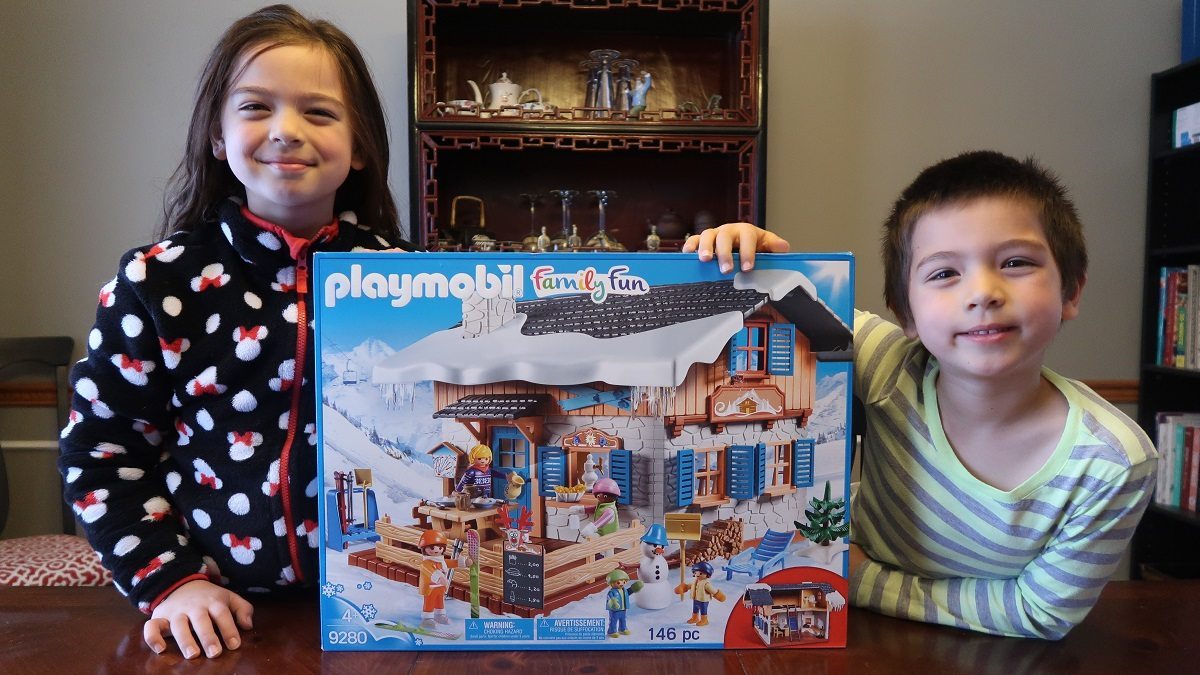Become a character from one of Paige Turner’s pulp novels in this battle of wits and words.
What Is Paperback Adventures?
Paperback Adventures is a word-making rogue-like game for 1 (or possibly 2) players, ages and up, and takes about minutes to play. It’s currently seeking funding on Kickstarter, with three pledge tiers based on the number of characters included: $35 for one, $60 for two, or $80 for all three. The game combines some of the word-making deck-building of Paperback with something like a dungeon crawl, fighting monsters and building up an inventory of useful items along the way. It is primarily designed to be a solo game, with a 2-player variant in development as a stretch goal.
Paperback Adventures was designed by Tim Fowers and Skye Larsen and published by Tim Fowers, with illustrations by Ryan Goldsberry.
New to Kickstarter? Check out our crowdfunding primer.

Paperback Adventures Components
Note: My review is based on a prototype copy, so it is subject to change and may not reflect final component quality. Many of the cards were still missing artwork, and the graphic design of the other cards may not be complete. The prototype included components for 2 characters, so it would be close to what you’d get at the $60 pledge level. The enemy track and player track were simply cards in the prototype but will be designed by GameTrayz in the final product.
Here’s what comes in the core game box:
- Enemy track
- Player track
- 8 tokens (health, energy, etc.)
- 13 Double-sided Enemy cards
- 13 Reward cards
- 7 Sleeved Penalty cards
- 7 Special Vowel & Wild cards
- 24 Item cards
- 24 McGuffin cards
And here’s what comes in each character box:
- 3 Enemy cards
- 3 Reward cards
- 60 Sleeved Letter cards
- 4 Core Item cards
- 3 Bonus Item cards
- 3 Bonus McGuffin cards
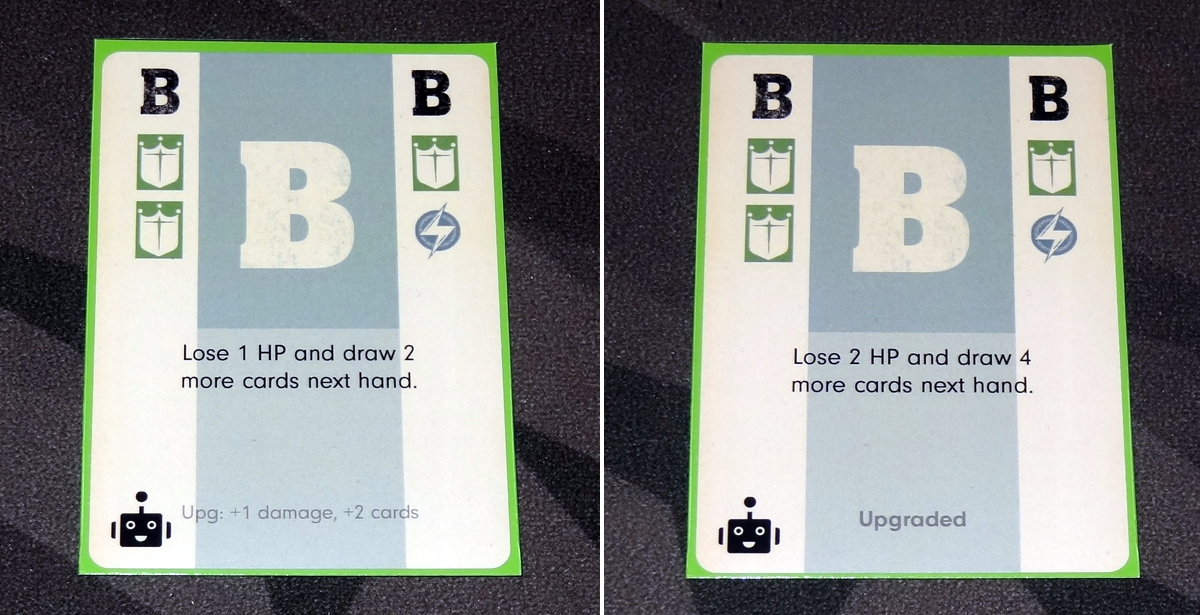
The letter cards are sleeved because they’re double-sided: they can be flipped to the other side to upgrade them with more powerful abilities or additional icons. (The penalty cards are sleeved simply to match the rest of the deck.) The prototype used plain green sleeves but these may end up being custom Paperback Adventures sleeves.

The illustrations for the game will be by Ryan Goldsberry, who has illustrated all of Tim Fowers’ other titles as well, like Burgle Bros. and Paperback. The character cards are made to look like old pulp paperbacks (written by Paige Turner, of course), complete with a 15-cent price sticker and taglines. Currently there are two announced characters, which were also in the prototype: Ex Machina, a robot with a giant laser, and Damsel, a thief who specializes in a powerful poison. A third mystery character will be revealed during the campaign.
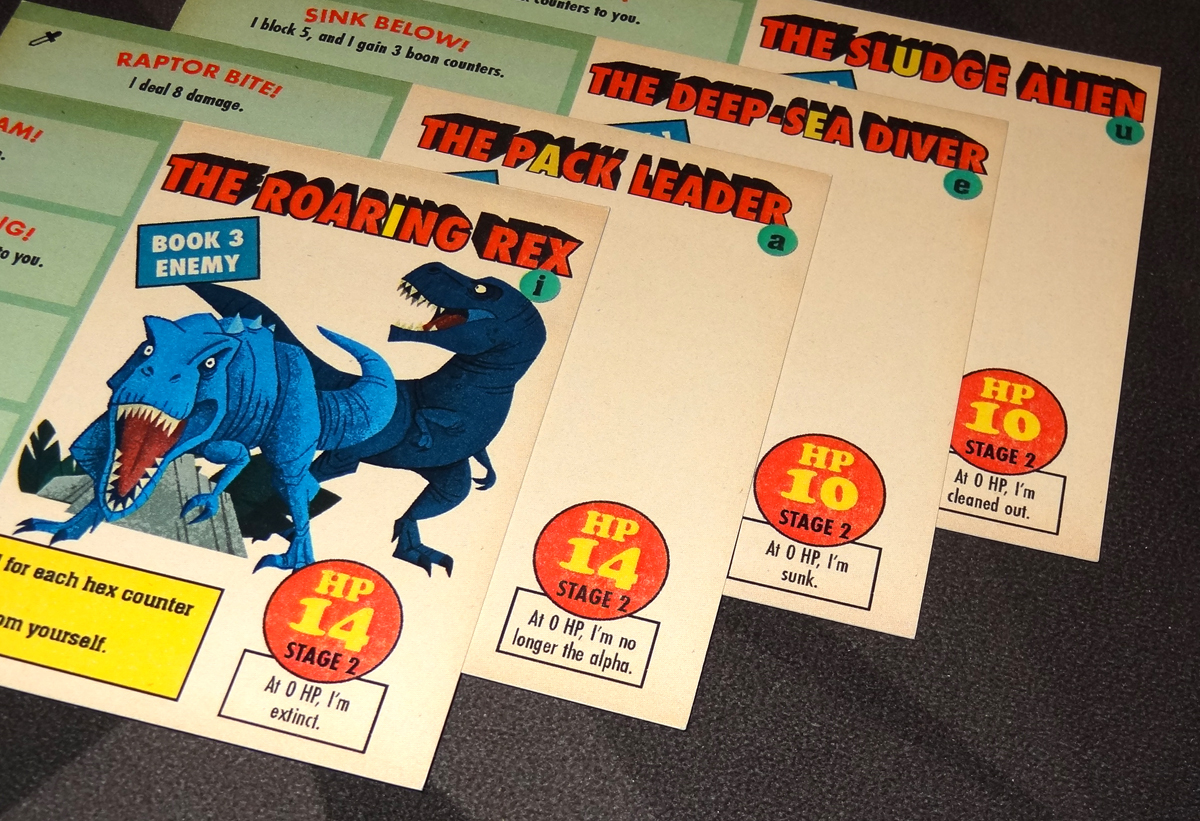
The enemy cards also look a bit like old book covers, though with a shared format. They’re double-sided to represent the two stages of each enemy, and the cards also have some silly punch lines for when the enemy is defeated. For instance, the Deep-Sea Diver says: “At 0 HP, I’m sunk.”

There are various square item cards, including the McGuffins, a special type of item. These are double-sided and have fun names, mostly literary references of some sort, and you have to pick which side you want to use when you gain a McGuffin.
How to Play Paperback Adventures
You can download a draft of the rulebook here.
The Goal
The goal of the game is to survive three “books,” each consisting of two enemies and a boss.
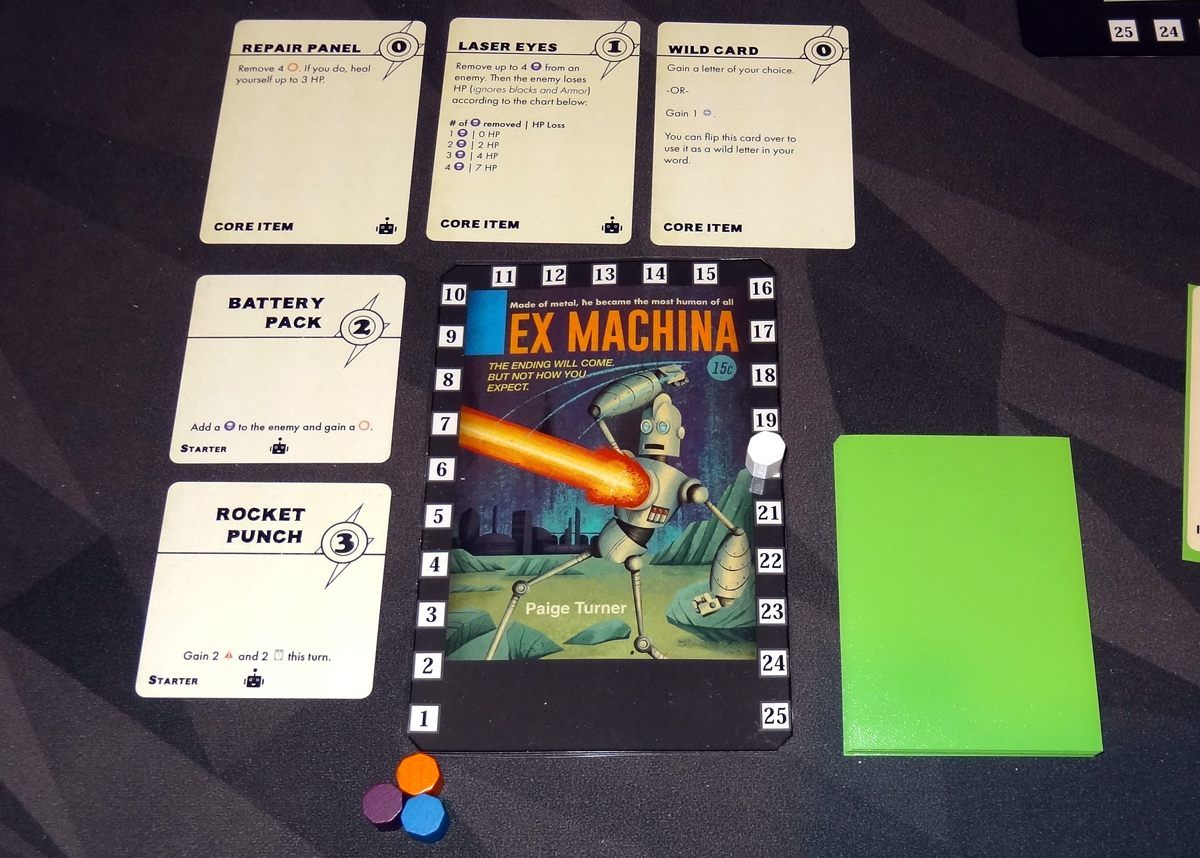
Setup
Pick a character—Ex Machina (the robot) or Damsel (the thief)—and retrieve the components for that character: the character sheet, starting cards, growth cards, and items. Put the health marker on 20, and set the boon, hex, and mana tokens nearby. Shuffle your starting cards, lay out your items in front of you, and set the growth cards to the side. Also, shuffle the penalty cards and place that aside.

For each “book,” you’ll fight two normal enemies and then a boss, and you can choose randomly from the cards for that particular book. The enemy card is placed “Stage 1” side up on the enemy mat, with the health marker placed on its starting health. Set the enemy intent marker on A1, and the hex and boon counters nearby. Also set the enemy vowel card (the one highlighted in the enemy name) nearby.
Gameplay
On your turn, you draw 4 cards from your deck and try to make a word with them. You may include the enemy vowel card in your word, and you also start with a wild card that can be used as any letter (though you’ll earn mana if you don’t use it as a letter).
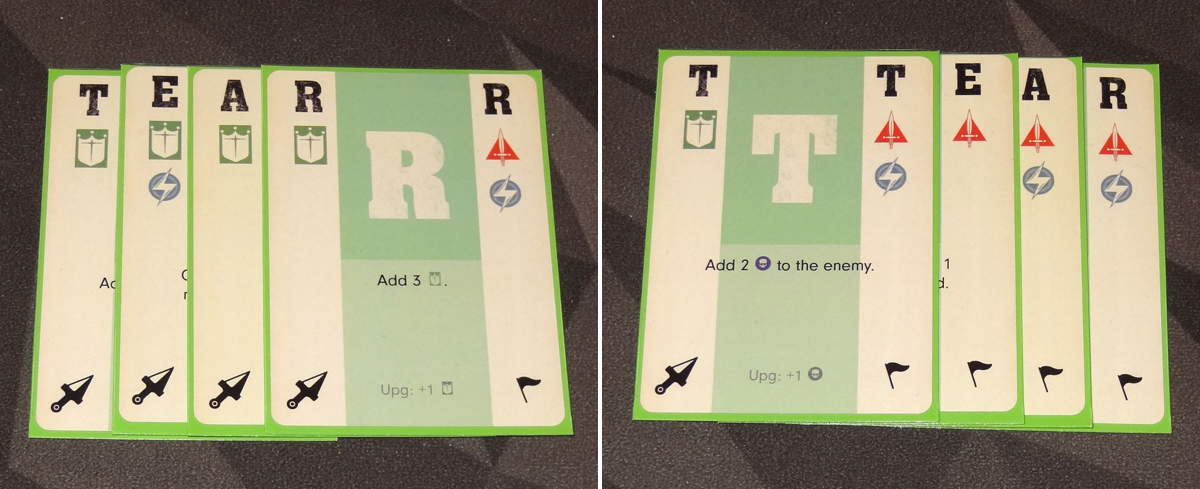
Once you’ve made a word, you may splay it right or left; typically splaying left will reveal more shields for defense, and splaying right will reveal more swords for attack. The cards also have abilities, but you only use the ability of the topmost card.
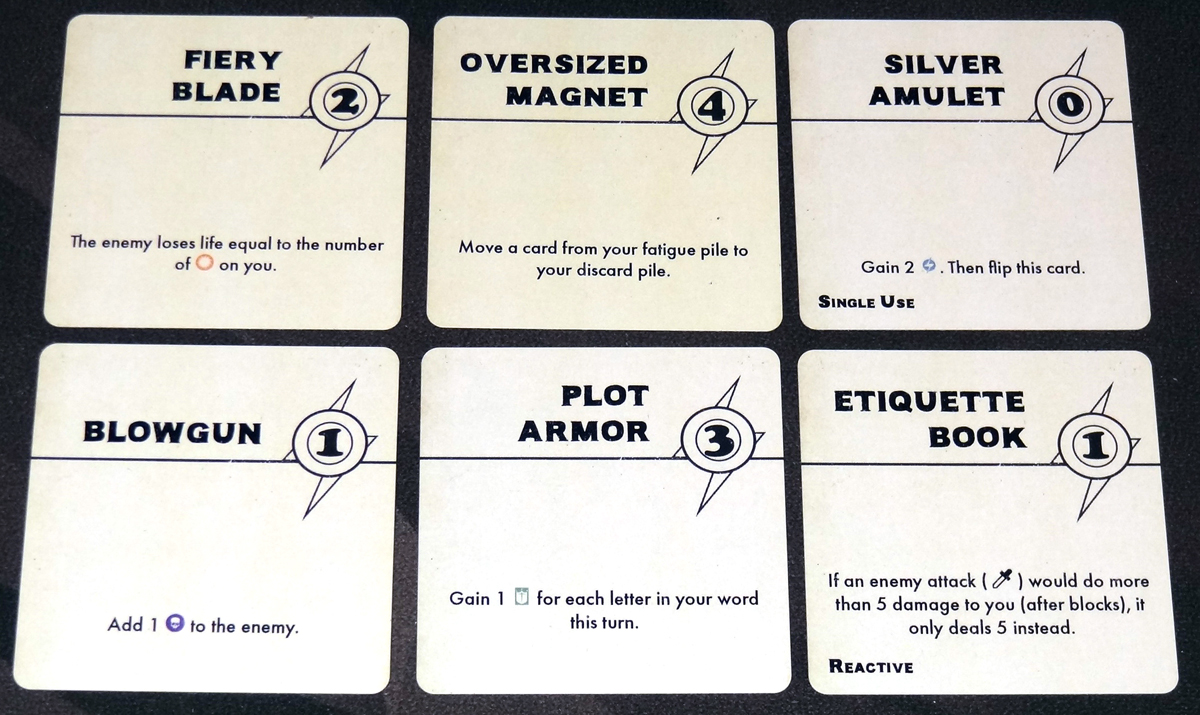
You may spend mana to use your items—each item may be used once per round (though there are some single-use items that are flipped over when used). McGuffin cards are a special type of item card that doesn’t require mana, but instead has an effect that is triggered by specific conditions.
Once you are done using items, you trigger your attack: add up your swords and reduce the enemy’s health by that much. (If enemy’s current action says it blocks damage, then you subtract that much damage from your attack.) Then, you earn mana based on the lightning symbols shown on your cards. Finally, the enemy does its action, which may be an attack (which reduces your health, but can be mitigated by shields on your cards) or other effects including boons or hexes on you or the enemy. Then advance the enemy intent marker to the next available action.
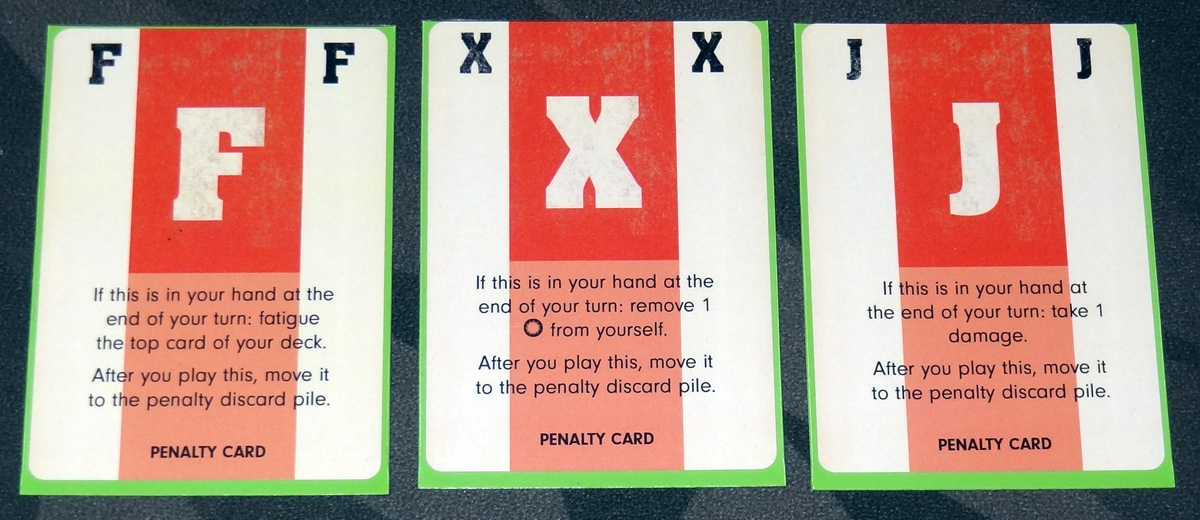
Some effects may add penalty cards to your deck: these will usually have a negative effect if they’re left in your hand, so you’ll want to use them in your word if possible, even though they don’t add any swords, shields, or mana. Once used, they go to a separate penalty discard pile.
At the end of your turn, move the topmost card from your word to the fatigue pile—that card is essentially out of the game until the end of this fight. The rest of the cards in your hand and word are discarded, and you draw 4 more cards for your next turn. If you run out of cards in your deck, reshuffle your discard pile and continue drawing.
If the enemy vowel is your topmost card, its effect is to advance the enemy intent marker one space, so it can be used to skip over a particularly nasty enemy action. However, then the enemy vowel card is moved to the fatigue pile rather than available to be used again in your next word.

When you reduce the enemy to 0 health during the first stage, it is “stunned”—you flip the enemy card over, reset its health to its Stage 2 starting health, and reset the enemy intent marker to the first action. However, the turn that it is stunned, it skips its action.
Battle End and Character Development
If you reduce the enemy to 0 health in both stages, then you win, and continue to a Character Development phase.

After you defeat an enemy, you get to draw one of the reward cards, which are separated between basic enemy and boss rewards. Each card is double-sided, with a number of effects on each side. Choose one side, and perform all of the effects on the card in order. These may include swapping out a card from your deck with a card from the growth deck, upgrading letter cards or your core items, or getting new items and McGuffins. Some rewards offer healing or let you start the next game with boons or mana. Boss rewards are a little more powerful, and will include adding cards to your deck rather than just replacing them.
Once you’ve finished with Character Development, you gather up all of your cards (including the ones in the fatigue pile) and set back up for the next fight. Note: you start with 0 mana, boons, and hexes for each new fight, but your health does not reset to its maximum level.
Game End
If your health is ever reduced to 0, well, it’s game over for you—reset the whole thing and try again!
However, if you defeat all the enemies and bosses for all three books, then you win the game!
2-Headed Giant Variant
The 2-player rules are still in development (it’s one of the stretch goals), so this may be subject to change. Two players play as a team, using the same deck and character track, so they share health, mana, boons, and hexes. The starting items are divvied up between the two players (as are items earned as rewards), and you may only use your own items during your turn.

Why You Should Play Paperback Adventures
Paperback Adventures is a little hard to categorize. Some of the gameplay will be familiar to players of Paperback or Hardback, where you’re drawing cards from your deck and making words, and the letter cards themselves have special effects. However, the deck-building in Paperback Adventures is a little more gradual, the splaying left or right is a new feature, and the thematic goal has changed from earning fame and prestige to a battle for survival.
First, let’s take a look at the word-building itself. Typically you’ll have a hand of 4 cards from your deck, so these may include vowels or consonants—and good luck if you get a whole hand of vowels! You also have access to two other letters: the enemy vowel (which stays the same for the duration of that particular enemy) and your wild card core item. There are things that will allow you to draw more cards, or force you to draw fewer, but generally you’re working with up to 6 letters each turn.
So, what word do you make? In this game, it’s usually not about impressing anyone with your wit because it’s primarily a solo game. Instead, you’re trying to come up with a combination that will either damage the enemy or protect you against attack, with hopefully some other beneficial effects thrown in. The decision to splay left or right will determine whether you get more swords or shields, but also which letter is on top for its ability. (Unlike Paperback and Hardcover, you only get one letter’s ability per word, rather than every letter in the word.) Penalty letters tend to be the less commonly used ones like J and Z, but if you don’t use them you get stuck with bad effects.
Both you and the enemy have boons and hexes, also just tracked with a little token. Some enemies will gain boons as part of their actions, and then those boons will let them do extra damage, or block attacks, or make you draw fewer cards. Your character and your items will determine how you use boons and hexes. For instance, the Damsel’s hexes represent poison—she can build up poison on the enemy, and then trigger her “Venom Vial” item to do a lot of damage, while leaving most of the hexes in place for future attacks; her boons can be used to block a limited amount of damage. On the other hand, Ex Machina has to spend more hexes to do damage with his Laser Eyes, but he can also use his boons to heal.

Next, consider the deck-building. In most deck-building games, you start with a basic deck, and you might be adding cards to your deck every turn, so by the end of the game your deck could have changed significantly from where you started. Paperback Adventures reminds me a little more of the Pathfinder Adventure Card Game, where you slowly deplete your deck over the course of a game, and you only make significant changes to your deck in-between sessions. It’s actually a little slower than that, because in Pathfinder at least you may be collecting cards during a scenario—in Paperback Adventures the only cards you’re likely to add to your deck mid-game are penalty cards.
Each time you play a word, you use the ability of the topmost card and then it goes into your fatigue pile, so you actually lose cards over the course of the battle. If you don’t take down the enemy in time, you could theoretically reach a point where you have no more cards to draw. (Don’t worry: this is pretty unlikely, because you’ll probably be dead before then anyway.) If you defeat a basic enemy, you’ll swap out cards from your deck or upgrade them, but the number of cards in your deck doesn’t actually increase until you defeat a boss—similar to the way that your overall deck size in Pathfinder only increases when you take certain skill upgrades, so the deck-building is more about which cards to include rather than just growing the deck.
What you do accumulate in Paperback Adventures is the items and McGuffins, which are spread out in front of you in a tableau. The McGuffins are nice because they don’t require mana to activate, but they may also be more limited in effect. (The more powerful McGuffins, marked with a gem icon, will add 2 penalty cards to your deck when you first take them.) Most items can be used once per turn, and there’s a mix of effects, whether it’s extra damage or gaining boons or giving you extra letters to work with—but you’ll need some way of powering them up. Your three core items can also be upgraded, boosting their effects. Upgrading the wild card lets you use it as 2 consecutive letters instead of one, and also gives you 2 mana if you don’t use it in your word.
So far I’ve played through Paperback Adventures twice, one with each character, and I tried to mix up the enemies I fought so I could see the variety. I like the way the enemy actions work—each one feels a bit different in the way that it attacks you or defends itself, and the two-stage battle also has that feel of old-school videogames where the boss fights shift midway and the boss unleashes a new attack mode. I did survive and win with both characters, though I came within 2 HP of dying in my second play. Thank goodness for healing effects on the boss rewards! I haven’t gotten to try out the 2-player cooperative mode, but I like the idea, since I don’t play as many solo games myself (and hopefully once my vaccination kicks in, I’ll be playing a lot more multiplayer games again!).
If you enjoyed Paperback and Hardback, you may enjoy this twist on the word-making genre, which takes things in a weird but fun direction!
For more information or to make a pledge, visit the Paperback Adventures Kickstarter page!
Click here to see all our tabletop game reviews.
![]() To subscribe to GeekDad’s tabletop gaming coverage, please copy this link and add it to your RSS reader.
To subscribe to GeekDad’s tabletop gaming coverage, please copy this link and add it to your RSS reader.
Disclosure: GeekDad received a prototype of this game for review purposes.



